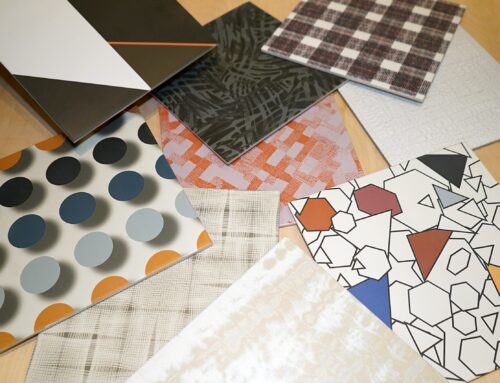You mean there’s something other than the PINK stuff? For years, the standard material for insulation has been fiberglass batt. Think Pink Panther. And while fiberglass batt may be the right insulation for either part or all of your project, it’s worth taking a look at newer materials that are transforming the way we insulate.
Fiberglass
Fiberglass insulation is really glass that is spun into long fibers, then woven together and coated with a binding agent. A more eco-friendly choice is fiberglass batt with 30 percent or more post-consumer recycled glass. Fiberglass insulation is available in loose-fill, as rigid boards and as batts or blankets.
Fiberglass batts are so popular because they are relatively easy to install, being manufactured to fit the standard spaces between studs (12, 16 and 24 inches). Fiberglass is both fire and mold resistant and moisture in small quantities has little effect on its R-value.
But, batts aren’t so convenient if you have irregular spaces that need to be insulated. They can’t be shaped easily and this results in air movement around the insulation that significantly reduces the R-value of fiberglass.
R-Values range from 2.2-3.2 for unfaced insulation. Fiberglass batts are available with a vapor barrier made of foil or kraft paper which prevents moisture absorption, but this also lessens the R-Value of the insulation. And remember that fiberglass batt depends on its air pockets to achieve its R-Value so if it is compressed into a small space, these air pockets are crushed and the R-Value is reduced.
Mineral Fibers
Insulating mineral fibers include slag wool, which is made from industrial or steel mill slag that is then spun into fibers. The fibers are woven into batts after being treated with oil and binders that decrease dust and help maintain the form of the material. Another mineral-fiber insulation called rock wool is manufactured similarly using natural basalt rock instead of industrial slag.
Mineral-fiber is very similar to fiberglass in look, feel, and performance. Since it will not melt or support combustion, it is a good choice for insulating around chimneys.
Cellulose
Cellulose insulation is made from finely shredded newsprint that is chemically treated to resist fire, corrosion, fungus and insects. In fact, cellulose has a class-1 fire rating making it an exceptionally safe product. Newsprint cellulose usually contains at least 70 percent post-consumer recycled paper so it is also a very environmentally friendly choice.
Dry cellulose insulation must either be poured in place or blown due to the small size of the particles. This particle size is what gives cellulose insulation the ability to ‘flow’ around obstructions such as nails, electrical wires, trusses and braces to fill spaces uniformly. Netting holds the insulation in place. Wet cell spray insulation is mixed with a bonding agent and sprayed into a wall cavity.
Cellulose is considered a “green” product for both health and environmental reasons. It doesn’t contain formaldehyde, it doesn’t itch like fiberglass and cancer warnings are not required on its labeling.
When using cellulose, you have to be sure to install the product to the manufacturer’s density recommendations or it could settle over time causing it to under perform.
Spray Foam
Polyurethane is the most common form of spray foam and when foamed in place, it has an R-value of about 6 per inch. Advantages of foamed-in-place insulations include: they provide excellent air sealing and vapor barrier control as well as having excellent insulation qualities. Spray foam has the added advantage of being able to completely seal a space when properly installed, leaving no compromising air gaps.
Rigid Foam
Rigid foam insulation is a rigid sheet that is installed directly to the framing. Several types of foam derived from plastic materials are available with high R-Values per inch, including expanded polystyrene (R 4.0 to 4.5), extruded polystyrene (R 5.0 to 5.5), and polyurethane (R 6 to 7.5). Rigid foam is a great choice where space is very limited and a high R-value is important.
It can be installed on either the interior or exterior of a wall, but if it is used on the inside it must be covered by a fire-resistant material like wallboard. Rigid foam insulation can act as both an air and vapor barrier as long as the joints between the panels are sealed correctly.
“Expanded” types of rigid foam insulation like expanded polystyrene are now manufactured with a non-chlorofluorocarbon (CFC) gas which make them the most environmentally friendly rigid foam choice. “Extruded” types, which offer higher performance, have switched to using hydrochlorofluorocarbons (HCFCs), which are safer for the environment.
Rigid foam insulation tends to be more expensive than most other types of insulation but it also provides higher R-Values. It is also very important for long-term performance for rigid foam insulation be protected from prolonged exposure to sunlight or water.
When rigid foam is used in SIPs, if EPS is the core material, it will burn at lower temperatures than polyurethane or isocyanurate which burn at the same temperature as wood.
Cotton Fiber
For people particularly interested in using natural products to insure uncompromised indoor environmental quality, consider cotton insulation. It has a high recycled content, it has a Class-1 fire rating, it is safe to handle and its R-Value is comparable to fiberglass. Like fiberglass, it comes in batts that are easy to install.
Soy
Soybean based insulation contains no urea/formaldehyde and they do not release VOCs. They are, however, processed with chemicals.









Leave A Comment
You must be logged in to post a comment.